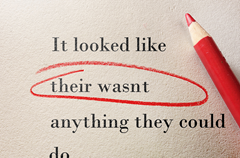19. Using punctuation
People are terrified of punctuation, but there’s really no need. Believe it or not, you don’t have to be perfect… you simply have to write in a way that is easy to understand.
 Please don’t run and hide, I promise this is going to be a lot easier than you think. There is absolutely no need for you to turn yourself into a punctuation ninja for the purposes of writing a powerful LinkedIn profile.
Please don’t run and hide, I promise this is going to be a lot easier than you think. There is absolutely no need for you to turn yourself into a punctuation ninja for the purposes of writing a powerful LinkedIn profile.
I will say, however, that any number of purists are going to strongly disagree with what I have to say on this subject.
Regardless.
Punctuation has one (and only one) purpose: to help you communicate to your audience how they should read your writing.
In other words, punctuation is simply there to make your writing clear, powerful, and easy to understand.
With that in mind, there are very few actual ‘rules’ to be followed.
There’s a great book on grammar and punctuation (I know…) by Lynne Truss, in which she tells the story of a panda, who walks into a restaurant and orders some food. When he’s finished eating, he takes out a gun, shoots a fellow diner, and walks out.
Ow you may well be wondering what on earth that story has to do with grammar and punctuation, but it’s actually
very simple. The story was inspired by a description of pandas the author had found in a wildlife book:
Panda. Large black-and-white bear-like mammal, native to China. Eats, shoots and leaves.
By introducing a comma into the sentence (and thus a pause between the words ‘eats’ and ‘shoots’), the writer had completely changed the meaning of the sentence. Instead of a description of eating habits of pandas, we now have the mental image of a large black and white bear who shoots people and walks out after each meal.
Probably not what the author of that wildlife book was trying to communicate.
The lesson we learn from this comical story is that commas are simply designed to inform the reader that they should pause before progressing to the next word in the sentence. If you aren’t sure whether a comma is necessary, simply speak the sentence out loud as you would like it to be read, and decide whether or not you want your desired audience to pause at that point.
Now, I’m not about to cover every individual rule of punctuation. It would take up a lot of time, and most likely a lot of people would skip over it.
And I don’t blame them. Punctuation is pretty tedious.
It’s entirely possible, and indeed often desirable, to write your entire LinkedIn profile using only commas, full stops, and paragraph breaks.
I will, however, cover the use (and misuse) of the apostrophe.
You’re trying to open the wrong locker. That locker isn’t yours, it’s David’s.
There are quite a few rules to learn if you want to use apostrophes, so you may well decide you simply don’t want to. It is, for example, highly unlikely you’ll need to use possessive apostrophes in your LinkedIn profile (David’s, Michael’s, etc.), and it’s also rather easy to avoid using apostrophes altogether by writing out the longer versions:
You’re = You are
It’s = It is/It has
I’ve = I have
I’d = I would
I’ll = I will
See what I mean?
On the other hand, if you’re welling to jump into the viper’s nest of English punctuation and grammar, I applaud you. Eats, Shoots and Leaves by Lynne Truss is an excellent introduction to the subject.
Finally, I want to make a short point, but one I feel is important. The exclamation mark should only be used if it’s necessary to achieve a certain meaning.
In William Zinsser’s On Writing Well, he notes that “It has a gushy aura, the breathless excitement of a debutante commenting on an event that was exciting only to her.” – If in doubt, leave it out.
Worse, though, is the use of an exclamation mark to indicate that something is supposed to be funny. There isn’t much space for humour in a LinkedIn profile to start with, so this definitely isn’t the way forward.
Just like canned laughter on a TV show, using exclamation marks to signify humour is patronising and irritating.
In all honesty, I can’t recall a time when I’ve seen a LinkedIn profile, and thought it would have been better off with more exclamation marks. I have, on the other hand, seen many which could have done without.
With this is mind, I would recommend excluding them entirely from your LinkedIn profile, and instead attempting to maximise the power of your writing in other ways. Well worded, engaging sentences are always more effective than trying to ‘spruce up’ your profile with punctuation.
20. Edit Ruthlessly
Editing is a stage that’s usually skipped, but you should absolutely make it a staple of your writing process. And it’s not just to find and correct errors… Whenever you write anything, you must be willing to “kill your darlings”.
 This is, in my opinion, the single most important part of the LinkedIn profile writing process.
This is, in my opinion, the single most important part of the LinkedIn profile writing process.
It doesn’t matter if your first draft is terrible, so long as it never sees the light of day. Your first draft is always for you – All that stands between it and the rest of the world is a series of brutal editing runs.
It’s often said that in writing, you must kill your darlings – a quote that’s been attributed to Oscar Wilde and William Faulkner, among others.
Stephen King took it a stage further, with “kill your darlings, kill your darlings, even when it breaks your egocentric little scribbler’s heart, kill your darlings.”
These quotes are highlighting the importance of cutting away the unnecessary. You might be pleased with a sentence or paragraph, but does it further your point? Is it vital that your readers have this information? There are strict character limits for LinkedIn profiles, so if the answer is no, cut it.
The same goes for filler words that don’t add to the meaning of a sentence. Hopefully there won’t be too many of these if you’ve taken tips 4 & 5 to heart. But if there are, now is the time to cut them out.
The easiest way to edit your work is to print it out and read it. This is best done a day or so after you’ve finished writing, as it gives you a chance to take a fresh look.
On your first read through, you’re looking to see whether your LinkedIn profile flows logically. Does it make sense? Does it provide all of the necessary information? Do any paragraphs need moving, or removing? Don’t worry about typing errors or specific language at this point – we’re more concerned with the overall purpose at this stage.
Once you’re happy that your profile achieves all it set out to, it’s time to dig into the details. Read through again, and mark any words, phrases or sentences that don’t further your point.
I don’t care if you thought it was clever, and neither will your readers. Get rid of it.
Underlining, highlighting or bracketing the offending areas are good ways to do this.
Finally, it’s time to make sure that your profile is as strong as you can make it. Print out your revised copy, and read it out loud. Yes, really. You’re looking for any sentences that don’t flow off the tongue easily.
I know, I know – You’re not a poet. But if a sentence doesn’t flow off the tongue, that’s an indication that it’s not as simple as it could be. Perhaps you didn’t tell the reader what (or when) you were referring to until the end of a sentence. Perhaps you’ve used three words where one would do, or one long sentence where really it should have been two.
Whatever it is, mark it, keep going, and correct it when you’ve finished.
When you sit down to write your LinkedIn profile, by all means give in to the temptation to include things that
seem clever or witty. Indulge your ego and flex your artistic flair.
But when it comes time to edit, you must be willing to kill your darlings.





